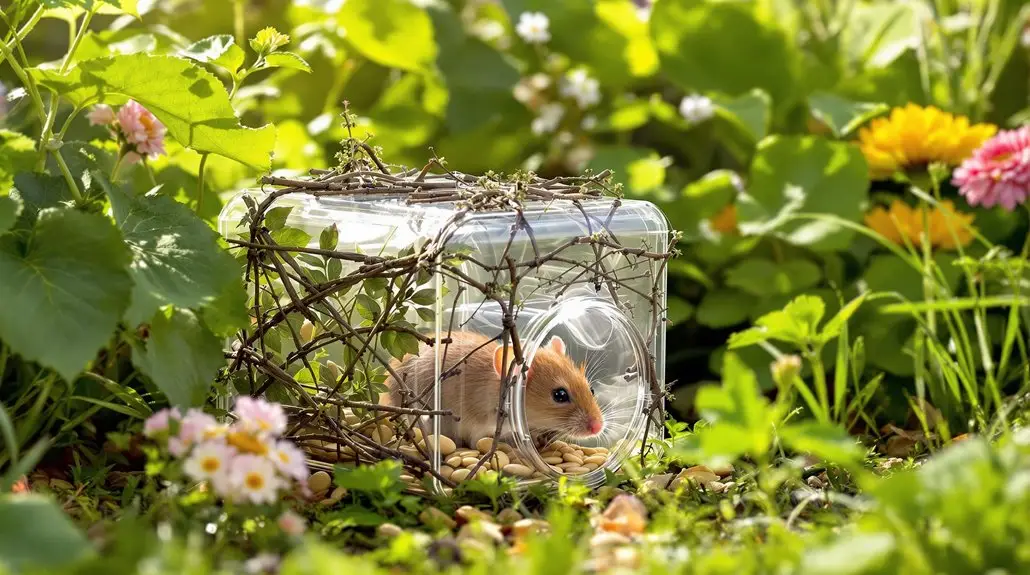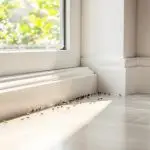Natural pest control for mice can be highly effective and secure for your home. Start by using essential oils like peppermint or eucalyptus, which mice dislike. You can mix these oils with water for a natural spray or place soaked cotton balls in key areas. Consider sealing entry points with wire mesh and keeping your surroundings clean to minimize attraction. Additionally, use humane traps with enticing bait and check them regularly. Combining these methods will enhance your success in managing mouse populations. Discover more strategies to keep your space pest-free and comfortable.
Key Insights
- Use essential oils like peppermint, lemongrass, and eucalyptus as natural repellents; they disrupt mice’s senses and deter them effectively.
- Set physical barriers with wire mesh and sealants to block entry points, preventing mice from infiltrating your home.
- Employ humane trapping methods, placing traps near mouse trails and using appealing baits like peanut butter for better success.
- Maintain a clean environment by storing food in sealed containers and regularly inspecting for signs of mice or potential entry points.
- Combine natural repellents with practical methods like sealing gaps and maintaining cleanliness for a comprehensive mouse management strategy.
Effective Essential Oils

Using effective essential oils can be a powerful way to repel mice from your home. These natural solutions not only keep your space smelling fresh but also help create a welcoming environment for you and your loved ones, free from unwanted pests.
Peppermint oil is a top choice, thanks to its potent, menthol-like scent. It disrupts mice’s nasal receptors, making it difficult for them to locate food and water. To use it, mix 15 drops of peppermint oil with equal parts witch hazel and water in a spray bottle. Spray it along baseboards, inside closets, and in dark corners. Remember to replace peppermint-oil-soaked cotton balls monthly for maximum effectiveness. Additionally, rodent control solutions can be implemented alongside these natural methods for greater efficacy.
Lemongrass oil, with its unique scent, can also deter rodents when combined with other essential oils. Use it at entry points to your home, ideally paired with citronella or rosemary for a stronger aroma. Using multiple oils together creates a more potent repellent effect.
Citronella oil is another excellent option, effective when applied directly to areas mice frequent, like baseboards and closets.
Don’t overlook cloves and cinnamon, which emit strong scents that mice dislike. You can use them whole or in oil form.
Rosemary oil, with its pleasant smell, works well too, especially when combined with other oils. Eucalyptus and lemon oil can also contribute to your pest-repelling arsenal.
Other Natural Repellents
When tackling a mouse problem, you might want to contemplate some household items that can work as effective repellents.
While mothballs can be tempting due to their strong scent, they come with serious health risks, especially around kids and pets. Natural options like plants such as lavender and mint can also serve as safe alternatives in repelling mice. Additionally, using essential oils derived from these plants can enhance the deterrent effect against unwanted pests.
You can also explore other strong-smelling substances, like mint toothpaste or even used kitty litter, which can help keep those bothersome rodents at bay.
Mothballs and Their Risks
Mothballs are often touted as a quick fix for rodent issues, but their effectiveness is more myth than reality. The chemicals in mothballs, like naphthalene and paradichlorobenzene, simply don’t do enough to deter mice or rats. Instead of solving your rodent problems, they might just leave your home smelling worse. The scent dissipates quickly, and before you know it, you’re left with the same issue you started with. Additionally, rodents are frequently known to enter homes and businesses in search of food and shelter, making it crucial to address the underlying issues.
Moreover, mothballs pose serious health risks. If inhaled or ingested, they can cause headaches, vomiting, and even respiratory issues. Long-term exposure is linked to more severe conditions, including hemolytic anemia and even cancer. If you have pets or kids, using mothballs can be especially perilous, as even a single one can be toxic if swallowed.
Additionally, the Environmental Protection Agency regulates mothballs, and improper use can lead to legal consequences. Instead of relying on mothballs, consider more secure alternatives like traps or preventive measures such as sealing entry points.
Keeping your home clean and clutter-free can also make a significant difference in keeping unwanted guests away.
Smells That Deter Mice
Natural scents can be powerful allies in your battle against mice, as many essential oils and household items emit aromas that rodents find repulsive.
Using peppermint oil can be especially effective; just soak cotton balls in it and place them in areas where you’ve seen mice. Eucalyptus oil has a sharp scent that, when applied daily, can greatly reduce rodent encounters. Strong odors disrupt mice’s sense of smell, creating discomfort in areas treated with these natural repellents.
For a revitalizing alternative, you might try spearmint oil or citronella oil, both of which deter mice with their pleasant fragrances.
You can also use common herbs and spices from your kitchen. Sprinkling cayenne pepper or placing cinnamon sticks in drawers and closets can create an unwelcoming environment for mice.
Don’t overlook household items, either—mix vinegar with water in a spray bottle and mist areas where mice are active.
Even used tea bags infused with lavender can help keep these pests at bay.
Embracing these natural smells not only enhances your home’s scent but also fosters a mouse-free sanctuary, making your space more inviting for you and your loved ones.
Kitty Litter Benefits
Using scents like peppermint and eucalyptus can effectively deter mice, but there’s another natural repellent that packs a punch: kitty litter.
The scent of cat urine in fresh litter signals danger to rodents, making it an effective deterrent. Here’s how you can make the most of kitty litter in your pest control efforts:
- Strategic Placement: Position litter near entry points like doors and windows where rodents might sneak in.
- Use Fresh Litter: Always opt for fresh litter, as its strong scent is essential for repelling mice effectively. Cat litter’s scent also creates an inhospitable environment for rodents, further enhancing its deterrent properties.
- Combine Forces: Integrate kitty litter with other natural repellents such as peppermint oil and vinegar for enhanced protection.
- Regular Maintenance: Keep an eye on the litter’s potency; replace it regularly to maintain its effectiveness.
Physical Barriers

To effectively keep mice out of your home, implementing physical barriers is essential. Start by covering vents and cracks with wire mesh, which prevents these little pests from squeezing through.
For gaps and holes in walls, floors, and foundations, sealants are your best friends. They fill those small openings that might otherwise go unnoticed. If you have larger holes, consider using hardware cloth or metal sheeting to block them effectively. Physical barriers create impassable obstacles for mice, making it crucial to ensure all entry points are secured.
Make sure all your window and vent screens are intact and free of holes. Installing door sweeps or weatherstripping will help fill any cracks in doors and deck boxes, creating a tighter seal against unwanted visitors.
For added security, use galvanized sheet metal or aluminum flashing—these smooth surfaces are hard for mice to climb.
When selecting materials, aim for a sturdy gauge: 24 gauge or heavier for metal sheeting and 19 gauge for hardware cloth.
If you’re dealing with concrete, remember that a minimum thickness of 2 inches for reinforced concrete creates a strong barrier.
Household and Yard Maintenance
Keeping your home and yard well-maintained is essential for preventing mice infestations. When you create an environment that’s unwelcoming to these pests, you not only protect your space but also foster a sense of comfort for yourself and your loved ones.
Here are some key maintenance steps to take into account:
- Reduce food and water sources: Store food in sealed containers, keep your kitchen clean, and eliminate standing water.
- Remove rodent hiding places: Clear clutter and dense vegetation around your home’s foundation to minimize cover for mice. Maintaining cleanliness can significantly lower the chances of attracting mice to your home.
- Maintain cleanliness and hygiene: Use tamper-proof bins for dry goods and make sure your trash cans have tight-fitting lids.
- Conduct regular inspections: Check for signs of mice and seal any potential entry points to keep your home secure.
Humane Trapping Methods

When using humane traps for mice, strategic placement is key to success. You’ll want to monitor the traps regularly to guarantee they remain effective and adjust their locations as needed. Once you’ve caught a mouse, secure relocation is essential to prevent any stress or harm to the animal. Providing a better environment for the mouse during relocation will contribute to its well-being.
Trap Placement Strategies
Effective trap placement is essential for humane mouse control, and strategically positioning your traps can greatly increase the chances of capture.
To get started, consider these key strategies:
- Near Walls and Baseboards: Place traps 1 ½ to 2 inches away from walls, ensuring the bait side faces the wall. This captures mice that prefer to travel along edges.
- Dark, Confined Areas: Set traps in dark spots like pantries or behind appliances, where mice feel secure. Avoid placing them near water sources.
- Along Travel Paths: Identify sooty trails on cardboard and place traps along these paths, especially near food sources or signs of mouse activity. Monitoring mouse populations can help you adjust trap placements based on the observed activity.
- Effective Baiting: Use irresistible baits like peanut butter or fried bacon, placing a small amount on the pressure plate to lure them in without overloading the trap.
Monitoring and Maintenance
Monitoring your humane traps is vital for guaranteeing the well-being of captured mice. Regular checks help minimize stress and dehydration for the little creatures you’ve caught. Aim to inspect your live traps every hour, especially if you’re using options like the Humane Smart Mousetrap.
Look for signs of activity, such as flour dust or paw prints, to know if a mouse is inside. When checking the traps, be gentle. If a mouse appears agitated, use a towel to calm it down. Verify the trap is secure and won’t harm the mouse when triggered. It’s also essential to set your traps in areas with mouse activity, using enticing bait like chocolate or peanut butter. Keeping the traps clean to prevent disease and maintain their effectiveness is important because mice prefer tight, small spaces for hiding from predators.
Avoid using sticky glue traps and snap traps; they’re inhumane and can cause unnecessary suffering. Remember, your aim is to help these animals while keeping your space rodent-free.
Safe Relocation Practices
After successfully trapping a mouse humanely, the next step is ensuring its secure relocation. You want to approach this task with care, both for the mouse’s well-being and to prevent it from returning. Here are some reliable relocation practices to follow:
- Release at least 100 yards away from the capture site to reduce the chance of re-infestation.
- Choose a location with food and shelter, such as wooded areas or fields, where the mouse can thrive.
- Avoid areas with immediate predators to protect the mouse after its release.
- If you prefer, consider taking the mouse to a local vet for humane euthanasia instead of releasing it.
When transporting the trapped mouse, use a piece of cardboard to slide under the trap gently. Lift it carefully to avoid stress or escape, and cover it with a towel to calm the mouse during the journey.
By handling the situation with compassion, you’re not only helping the mouse find a new home but also fostering a sense of belonging in your own environment.
Limitations and Alternatives
Natural mouse repellents may seem like an appealing solution, but they come with significant limitations that can hinder their effectiveness. For starters, many natural repellents offer only temporary relief. Mice can quickly get used to smells like peppermint oil, and products such as mothballs don’t provide a long-term fix. If you’re facing a severe infestation, these methods often fall short, leaving you frustrated and still in need of a solution.
Security is another concern. While you might think natural means secure, products like mothballs contain harmful chemicals. Even everyday items like cayenne pepper can irritate your skin, and some plants can be toxic to your pets. It’s essential to be cautious about what you use around your loved ones.
So, what can you do instead? Implementing exclusion methods, like sealing cracks and holes, can effectively prevent mice from entering your space. Keeping your home clean and clutter-free denies them food sources and hiding spots.
You might also consider traps or barriers for immediate control. Engaging a professional pest control service is often the most effective route for severe cases, as they’ve the expertise and tools to handle infestations securely. NaturePest, for example, specializes in natural and organic pest control methods that minimize the use of harmful chemicals.
While natural repellents can be part of your strategy, relying solely on them may not be the best approach. Combining these methods with practical alternatives can help create a more thorough plan that truly keeps your home mouse-free.
Frequently Asked Questions
Are There Any Natural Methods That Attract Mice Instead of Repelling Them?
If you’re looking to attract mice instead of repel them, focus on providing appealing food sources.
Leaving out grains, cereals, or pet food will draw them in. You might also consider using soft fabrics and paper for nesting materials, creating a cozy space for them.
Remember, cluttered and dark areas make great hiding spots.
By understanding what attracts mice, you can effectively create an environment that welcomes them.
Just be cautious!
How Can I Tell if My Home Has a Mouse Infestation?
To tell if your home has a mouse infestation, look for signs like droppings, gnaw marks, and holes.
Listen for unusual noises at night, and check for disturbed food packaging or scattered crumbs.
Notice any musky odors or increased pet activity; these can indicate mice are nearby.
What Are the Signs of Mice Living in My Walls?
If you suspect mice are living in your walls, look for signs like tiny black droppings around food sources and a strong, ammonia-like odor.
You might hear scratching or scuffling noises at night, indicating their movement.
Check for grease marks on walls and gnaw marks on packaging or furniture.
If you notice increased alertness in your pets or see nests made from soft materials, these could be clear indicators of a mouse infestation.
Can I Use Essential Oils in a Diffuser to Repel Mice?
You might think using essential oils in a diffuser could repel mice, but it’s not really effective. The scent may spread too thin to annoy them enough.
Instead, try soaking cotton balls in the oils and placing them near entry points. Spraying a mix of essential oils and water directly around mouse activity areas will likely work better.
How Long Does It Typically Take to See Results From Natural Repellents?
When you’re searching for results with natural repellents, think of a gentle breeze—refreshing but fleeting.
You might notice changes within a few days, but don’t expect miracles overnight. Often, it takes consistent application to see any real impact.
Remember, these methods are like whispers in a crowded room; they can get lost quickly.
To truly reclaim your space, combine efforts and stay vigilant. You’re not alone in this; many share your journey!
Create a Mouse-Free Sanctuary: Embrace Natural Pest Control with NaturePest!
In your quest for a mouse-free home in Florida, remember that nature often holds the key. By employing effective essential oils, physical barriers, and humane traps, you can restore peace without harsh chemicals. It’s like setting a stage for harmony—where every element plays its part. While these methods have their limits, combining them with diligent maintenance can lead to success.
So, why not embrace a greener approach to pest control with NaturePest Holistic Pest Control? Our natural solutions not only safeguard your home but also protect the environment. Take the first step towards a pest-free sanctuary today—your home, and the planet, will thank you!



